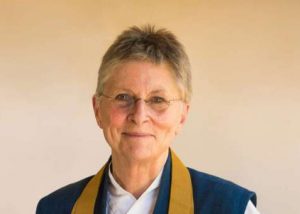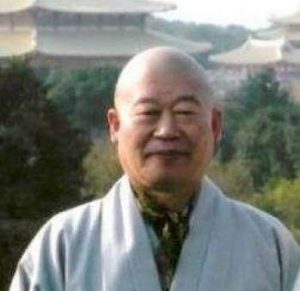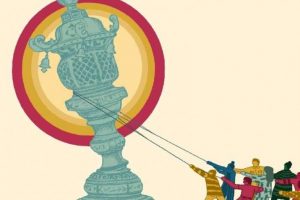Many Buddhist schools have formed since the introduction of the tradition from China to Japan in 552 CE. Some of them are essentially home-grown Japanese schools, while others can trace their lineage directly from Chinese traditions that might not even have survived institutionally in China until being re-imported from Japan in the modern period (for example, Shingon Buddhism).
The two main branches of Japanese Buddhism are Jodo Shin-shu and Nichiren-shu. Nichiren (1222–82), one of the most influential figures in Japanese Buddhist history, founded the Nichiren school of Buddhism. A deep thinker, Nichiren spent a good deal of time reflecting on the schools of Buddhism that populated the Japanese spiritual marketplace of his time, before deciding that the Lotus Sutra (Saddharmapundarika Sutra or the Sutra on the White Lotus of the True Dharma) was the most profound and trustworthy scripture.
The Lotus Sutra, which is regarded as one of the most important and revered Mahayana sutras, is said to have been composed around the beginning of the Common Era. It is the fundamental scripture for the Tendai/Tiantai and Nichiren schools of Buddhism. It also has exerted influence on other East Asian Buddhist schools, such as Zen/Chan.
A figure who is often compared with the later Martin Luther of Europe’s Reformation, Nichiren criticized the political and religious order of his time, which supported a wealthy elite with little regard for the hardships of common people or the pain of the deprived. Nichiren taught that anybody, including women and people with no formal education or religious training, can become buddhas in this life by reciting the gohonzon: “Namu-myoho-renge-kyo” with steadfast commitment and conviction. Of this unique commitment and theology, the Soka Gakkai organization says:
Nichiren Daishonin embodied his enlightenment – the fusion of reality and wisdom – in the form of the Gohonzon [mandala], the object of worship. The Gohonzon itself is the entity of the fusion of reality and wisdom. . . . With faith in the Gohonzon, one can realize the Buddha-nature inherent in one’s own life. Thus faith equals wisdom. Again, our Buddha-nature is reality and wisdom takes place within our own lives. Hence Nichiren Daishonin says in his Gosho, “Never seek this Gohonzon outside yourself. The Gohonzon exists only within the mortal flesh of us ordinary people who embrace the Lotus Sutra and chant Namu-myoho-renge-kyo.
(Daniel A. Metraux 1996, 368)
After Nichiren’s death, his disciples endeavored to compile the teachings he had left behind, resulting in a division in the school of Buddhism he founded. As a result of this method, several distinct Nichiren Buddhist schools developed, such as Nichiren Shushu, and the modern lay institution of the Soka Gakkai.
The Soka Gakkai is a lay organization with about 12 million members. The Soka Gakkai began as a branch of Nichiren Sho-shu, which was one of the earliest sub-schools of the broader Nichiren family. In the late 20th century, Nichiren Sho-shu and the Soka Gakkai had major disagreements about leadership and faith, which resulted in a schism and Nichiren Sh0-shu’s excommunication of the Soka Gakkai in 1991.
But what is the Soka Gakkai’s side of the story?
The Soka Gakkai
The Soka Gakkai was formed in the crucible of the growing militaristic imperialism of Meiji-era Japan. In 1930, Tsunesaburo Makiguchi (1871–1944), a Japanese educator motivated by Nichiren’s teachings, founded what was then called the Soka Kyoiku Gakkai (Value Creation Society), which he intended ase a lay Buddhist educational movement that advocated children’s dignity and the right to education that benefited them as persons, not only as instruments of the state. During World War Two, Makiguchi was arrested for protesting against the Japanese military, and died in prison from malnutrition and torture.

Toda Josei (1900–88), a student of Makiguchi’s who served as the Soka Gakkai’s second president from 1951–58, experienced a major conversion experience after reading the Lotus Sutra while also imprisoned. As a result, Toda modified Nichiren Buddhism’s teachings to better meet modern society’s needs. Under his leadership, the Soka Gakkai grew dramatically after the Second World War and swiftly became Japan’s largest lay Buddhist movement. Famous Soka Gakkai members included the late music star Tina Turner (1939–2023), while veteran jazz musician, bandleader, and composer Herbie Hancock remains a member.
The Soka Gakkai International
Daisaku Ikeda (1928–2023) succeeded Toda as president of the Soka Gakkai after Toda’s death in 1958. Ikeda stepped down as president in 1978, although until his death on 15 November, remained the de facto leader of the organization as honorary president of the Soka Gakkai and the president of the Soka Gakkai International (SGI).
In 1975, Ikeda founded SGI as an umbrella organization of the Soka Gakkai as a tribute to his mentor Toda’s dying wish that the teachings of Nichiren Buddhism be propagated across the world. Since then, the movement has built on its secular emphasis, making it easy to spread outside of Japan.
The Soka Gakkai is an outspoken advocate of banning nuclear weapons. In 1975, it gathered more than 10 million signatures from young people in a petition opposing such weapons, and presented them to the United Nations.
The Soka Gakkai believes that Nichiren’s teachings should be passed on in the spirit of fostering peace. As Ikeda said:
The core of the message of [Nichiren’s] Rissho-ankoku-ron is this: on a national, international, or worldwide scale the only way to bring about lasting peace is to establish the reign of the true Buddhist Law. . . . War strips loftiness and respect from humanity and, through its wicked actions, covers man with faith. It is only natural that Buddhism, the aim of which is to guide all people to the highest, purest realms, is bound to oppose war directly. By a like token, the Buddhist believer who is eager to practice his faith in the truest way regards it as his mission to pour his entire soul into the task of building peace.
(Jacqueline I. Stone 2003, 68–69)
Since 1983, SGI has issued a peace plan every year, including methods for tackling global issues based on Buddhist philosophy. Makiguchi and Toda founded the movement with the hope of improving Japanese education. As a result, it is not surprising that the Soka Gakkai has created its own educational system. Its practitioner headcount is relatively modest compared with the magnitude of its full membership. It has a small number of kindergartens, elementary schools, junior high schools, and senior high schools. There are also Soka Women’s Junior College and Soka University in Tokyo. Soka University has campuses in California and Paris. Soka University of America states on its website:
We believe that education is the road not just to a career, but to happiness, to fulfillment, and to a better, more peaceful, more sustainable world.
(Soka University)
SGI also promotes environmental activities through educational events such as exhibitions, seminars, and conferences, as well as more direct actions such as tree-planting campaigns. Among other environmental actions, SGI recently participated in the 28th Conference of the Parties (COP28) to the United Nations Framework Convention on Climate Change (UNFCCC), which took place in Dubai from 30 November–12 December. It argued for the active participation of global youth in policy processes concerning the climate crisis.
As of 18 November 2021, SGI’s aims and guiding principles have been updated in an effort to elevate the level of global citizenship, the spirit of active tolerance, and respect for human dignity. They are:
The Soka Gakkai will contribute to peace, culture and education based on the Buddhist teaching of respect for the dignity of all life.
The Soka Gakkai will promote an understanding of Nichiren Buddhism through grassroots dialogue and exchange, thereby contributing to the realization of human happiness and well-being.
The Soka Gakkai will respect and promote freedom of thought, conscience and religion.
The Soka Gakkai will, based on the Buddhist spirit of tolerance, respect other religious and philosophical traditions, engaging in dialogue and working together with them toward the resolution of the fundamental challenges confronting humankind.
The Soka Gakkai will respect local cultures and customs, and the autonomy of each organization. Each organization will develop its activities in accordance with the laws and conditions prevailing in that country or territory and will encourage its members to contribute to society as responsible citizens.
The Soka Gakkai will work for peace and a world free from nuclear weapons and will promote just and sustainable development.
The Soka Gakkai will safeguard and promote human rights. It will not discriminate against any individual and will oppose all forms of discrimination. It will contribute to the achievement of gender equality and promote the empowerment of women.
The Soka Gakkai will respect cultural diversity and promote intercultural exchange, thereby contributing to mutual understanding and cooperation among the world’s peoples.
The Soka Gakkai is committed to building a sustainable world for future generations, addressing the climate crisis, and protecting and caring for the ecosystems of Earth.
The Soka Gakkai will promote education, learning and scholarship, to enable all people to cultivate their individual character and enjoy contributive, fulfilling and happy lives.
(Sokaglobal.org)
Since Ikeda’s recent passing, this huge, global Buddhist organization will likely enter a period of change and restructuring as it adjusts to a new leader and revisits its aims and direction. Factors such as internal dynamics and leadership contestations, as well as external factors like Japanese politics and the global economy and geopolitical tensions, will fundamentally shape the group’s agenda.
Its most senior figures will inevitably seek inspiration from the one who started it all: Nichiren spent time in the mountains during his final years, where he wrote some of his most well-known treatises and letters. Many of the letters, which include some of his most profound teachings, were sent in gratitude to country residents and farmers in appreciation for food or clothes. Nichiren’s approach to Buddhism is distinguished by his concern for the welfare of common people and his belief in their inherent ability for buddhahood. The Soka Gakkai, which has a pronounced outward orientation in practice, will likely continue to embody this social aspect of Nichiren Buddhism far into the future.
References
Metraux, Daniel A. 1996. “The Soka Gakkai: Buddhism and the Creation of a Harmonious and Peaceful Society.” In Engaged Buddhism – Buddhist Liberation Movements in Asia. Edited by Christopher S. Queen and Sallie B. King. Albany: State University of New York Press, 365–400.
Stone, Jacqueline I. 2003. “Nichiren’s Activist Heirs: Sōka Gakkai, Risshō Kōseikai, Nipponzan Myōhōji. In Action Dharma – New Studies in Engaged Buddhism, edited by Christopher Queen, et al. London: RoutledgeCurzon, 63–94.
See more
Soka Gakkai Charter (Soka Gakkai)
Soka University (Soka University Website)
Related news reports from BDG
The Soka Gakkai Holds Memorial Ceremony in Tokyo for Daisaku Ikeda
Socially Engaged Buddhist and Soka Gakkai Leader Daisaku Ikeda Dies Aged 95
Soka Gakkai Council on Peace Issues Releases “Statement on the Israel-Palestine Situation”
Engaged Buddhism: The Soka Gakkai International Calls for Youth Engagement in Climate Policy at COP28
Soka Gakkai President Calls On G7 Leaders for Commitment to “No First Use” of Nuclear Weapons and Resolution to War in Ukraine
Related features from BDG
Does Buddhism Hold the Instincts for War?
Shakubuku! The Advent of Nichiren Buddhism in India
Nationalism: Collective Selves and the Promise of Buddhaland
Herbie Hancock: Jazz, Grammy Awards, and Nichiren Buddhism
Bodaisatta Shishobo – The Bodhisattva’s Four Embracing Dharmas, Part 1: Giving
















